|
|
|
Sort Order |
|
|
|
Items / Page
|
|
|
|
|
|
|
| Srl | Item |
| 1 |
ID:
096425
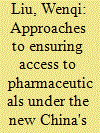

|
|
|
| 2 |
ID:
095087


|
|
|
|
|
| Publication |
2010.
|
| Summary/Abstract |
The teleological functionalism of Gellner's theory of nationalism has been much criticised. Attention here is on a different matter, namely Gellner's basic premise - that national homogeneity is a condition for societal success. We defend this view in a particular way - by showing that small, culturally homogeneous countries have advantages that often enhance their socioeconomic performance. They can coordinate policy in ways that help them respond successfully to the vulnerabilities of smallness. These capacities stem in part from the common bonds of nationalism and the resulting institutional capabilities for co-operation, sacrifice, flexible manoeuvring, and concerted state action. The argument is supported by a detailed analysis of the Danish case - a country whose impressive success has been deeply marked both by a diminution in size and an increase in national homogeneity. Less detailed examples of other countries are also presented. The conclusion urges caution as to the policy implications of the argument.
|
|
|
|
|
|
|
|
|
|
|
|
|
|
|
|
| 3 |
ID:
168664


|
|
|
|
|
| Summary/Abstract |
Energy storage technologies are receiving increasing attention in the UK and around the world as a means of increasing penetration of inflexible low-carbon electricity generation and optimising investment in energy infrastructure required to meet international decarbonisation goals. Research into the social acceptability of energy infrastructure has compellingly illustrated the importance of societal perceptions in the successful deployment of new infrastructure. However to date, no study has empirically examined public perceptions across the broad range of storage technologies available. We address this gap by presenting qualitative findings from four deliberative workshops held with members of the British public. We show that citizens underestimate the challenge of growing volumes of inflexible low-carbon electricity generation, and respond to storage technologies through reference to commonly perceived risks and benefits. When participants discussed how storage might be funded and managed, additional evaluative criteria emerged centred around equity, vulnerability, independence and convenience. Our findings suggest that perceptions of storage technologies tend to be ambivalent, and that acceptance is likely to be contingent on whether storage technologies can be designed, regulated and governed in ways which reduce technical concerns over safety, environmental impacts and reliability, while meeting societal desires for equity and the protection of vulnerable groups.
|
|
|
|
|
|
|
|
|
|
|
|
|
|
|
|
| 4 |
ID:
177431


|
|
|
|
|
| Summary/Abstract |
The transition to a digital, decarbonised, and decentralised energy system presents both risks and opportunities for the domestic consumer. Domestic ‘demand-side response’ (DSR), where household electrical consumption adjusts in response to external signals, has been envisioned in different ways with several trials demonstrating that DSR often has variegated and uneven consumer outcomes. This plurality of outcomes raises questions about the ‘winners’ and ‘losers’ of pursuing such policies and thus brings them into the realm of energy justice – a framing that seeks to understand the ethical implications of energy systems. This paper, based on an extensive review of current academic literature, evaluates the normative implications of DSR in relation to the eight principles of energy justice proposed by Sovacool and Dworkin (2015). Whilst there are several ways that DSR may create opportunities for furthering energy justice, there are also multiple risks of injustice, with much depending on how particular DSR programmes are designed and the presence or absence of sufficient policies to mitigate regressive outcomes. Further empirical research is required to better understand the conditions through which DSR can contribute to energy justice. We conclude by offering policy recommendations for those developing DSR or consumer protection policies related to DSR rollout.
|
|
|
|
|
|
|
|
|
|
|
|
|
|
|
|
| 5 |
ID:
177171
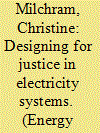

|
|
|
|
|
| Summary/Abstract |
In future urban energy systems, smart grid systems will be crucial for the integration of renewable energy. However, their deployment has moral implications, for example regarding data privacy, user autonomy, or distribution of responsibilities. ‘Energy justice’ is one of the most comprehensive frameworks to address these implications, but remains limited regarding smart grids, and regarding concrete guidelines for designers and policymakers. In this paper, we fill this gap by answering the following research question: How do design choices in smart grid projects impact energy justice? Thereby, four smart grid pilot projects are evaluated in a comparative qualitative case study research design. Data was collected through semi-structured interviews and a content analysis. Our findings contribute to the energy justice literature with insights regarding the design for distributive, recognition, and procedural justice. They underscore the importance of fairness in data governance, participatory design, user control and autonomy, technology inclusiveness, and the design for expansion and replication. Future research should explore the feasibility to govern smart grids as commons and the relationship between trust and perceptions of justice. We conclude with policy recommendations for funding future smart grid experiments and for facilitating the implementation of storage through electricity sector regulation.
|
|
|
|
|
|
|
|
|
|
|
|
|
|
|
|
| 6 |
ID:
128357


|
|
|
|
|
| Publication |
2014.
|
| Summary/Abstract |
In deregulated electricity markets, the transmission network is a key infrastructure for enabling competition in the generation sector. A deficient expansion of the transmission grid prevents the realization of the benefits in terms of efficiency associated with market mechanisms. Consequently, it is essential to provide clear investment policies and economic signals to attract timely and efficient transmission investments in order to develop the system at minimum cost meeting the requirements of generators and consumers, while keeping adequate levels of service quality and reliability. This paper proposes a modern tool of economic evaluation based on real options analysis that provides the regulator the ability to assess various incentives that would lead transmission investors to make efficient decisions in highly uncertain environments. Real options properly values partially irreversible investment decisions, such as to defer, modify or abandon an investment project in response to the arrival of new information or as uncertainties are resolved. Decisions are evaluated from the point of view of a transmission investor trying to maximize its own profits in the time period set to recover the capital invested. The results allow the study of the behavior of transmission investors regarding their decision making when they have the possibility to manage the option to defer, under different regulatory schemes that encourage the expansion of the transmission system.
|
|
|
|
|
|
|
|
|
|
|
|
|
|
|
|
| 7 |
ID:
188555


|
|
|
|
|
| Summary/Abstract |
With expanding solar and wind power production, the topic of flexibility services attracts increased attention in the Swedish energy system. In this context, the potentials in using thermal storage capacities in district heating (DH) systems have been brought forward, primarily by academic scholars. Using a ‘grounded’ approach, this study investigates if professionals assigned to Swedish DH companies and electricity distribution system operators utilise, or plan to utilise, DH systems as flexibility services for the electricity grid. Original data was collected through semi-structured interviews, held with fourteen individuals affiliated to different actors in the Swedish energy system. These individuals were identified as being experts, or practically engaged, in using DH utilities as flexibility services for the electricity grid. The findings show that although technologies for coupling between DH systems and the electricity grid are already in place, initiatives for using DH systems as flexibility services for the electricity system are rare in Sweden. Coupling challenges stem from ownership and operation legislation frameworks, marginal incentives and a widespread focus on firm benefits rather than energy systems benefits. Identified initiatives for using DH systems for flexibility services are primarily run on a local scale, designed and propelled by small groups of engaged individuals.
|
|
|
|
|
|
|
|
|
|
|
|
|
|
|
|
| 8 |
ID:
146201


|
|
|
|
|
| Summary/Abstract |
This article examines the trade effect of flexibility design features within preferential trading arrangements (PTAs). Using a gravity model of bilateral trade that incorporates multilateral trade resistance, we report three main results. First, unconstrained escape provisions undermine the effectiveness of PTAs when it comes to increasing trade. Second, adding some restrictions to these escape provisions more than offsets the negative effect of unconstrained escape, leading to more effective PTAs than those without escape options. Third, adding more restrictions beyond a certain point serves only to make PTAs less effective. Thus, both too much institutional flexibility and too much institutional rigidity reduces the ability of PTAs to promote trade. However, fitting these results to the descriptive data makes it appear that most PTAs would be even more trade effective if they included greater restrictions on the use of their escape provisions. Consequently, it appears that policymakers generally choose fewer escape restrictions than would be optimal in terms of trade performance.
|
|
|
|
|
|
|
|
|
|
|
|
|
|
|
|
| 9 |
ID:
113959
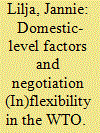

|
|
|
|
|
| Publication |
2012.
|
| Summary/Abstract |
Some suggest that the fault lines of the WTO's perceived failures actually lie in failures at the domestic level. This study examines the factors that can explain flexibility (and inflexibility) in multilateral trade negotiations within WTO member states. To shed light on the role of domestic factors in influencing WTO positions, we examine one member state in connection with a high-level meeting. India at the July 2008 Ministerial is selected primarily for methodological reasons. The empirical analysis provides preliminary support for the proposition that domestic policy-making structures marked by continuous information exchange and coordination are more likely to yield negotiation flexibility in multilateral talks. More specifically, the intense interaction that marks the relationships between actors involved in policy making on Non-Agricultural Market Access (NAMA) and services, where the Indian negotiation position was flexible overall, stands in contrast to what took place in the area of agriculture, where India took a manifestly inflexible stand. Competing explanations fail to fully account for the variation in these negotiating postures. A key insight from the analysis is that organized and regularized consultations, involving the same actors over time, are important. There is also a need for public outreach strategies in connection with high-level WTO meetings.
|
|
|
|
|
|
|
|
|
|
|
|
|
|
|
|
| 10 |
ID:
144197


|
|
|
|
|
| Summary/Abstract |
This paper considers how existing concepts underlying the development of the Internet are being strained in the emerging Internet of Things (IoT). It also explores how the well-known and tried Domain Name Service concepts, which map hierarchic names to addresses, can be extended for the IoT. The extension greatly broadens the concept of name/address mapping to digital objects with identifier/attribute database mapping for physical objects, applications, and data. Finally, this essay discusses the properties of the identifier management systems, showing how scalability, security, and flexibility can be supported in the IoT.
|
|
|
|
|
|
|
|
|
|
|
|
|
|
|
|
| 11 |
ID:
166474
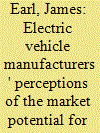

|
|
|
|
|
| Summary/Abstract |
While there is extensive research on the technical potential of electric vehicles (EVs) to provide electricity system flexibility, no work has sought to understand how EV manufacturers see their role in this transition. Here we present an interview study with 11 EV manufacturers active in the UK, determining their perceptions on the market potential for demand-side flexibility using EVs. Findings indicate manufacturers view significant potential in this market, but believe time is needed (i.e. in the 2020s) for the EV market to develop before there is enough system/consumer demand for flexibility using EVs. They believe better price signals are needed, and prefer a consumer-led approach (rather than, for example, mandatory smart charging). Most manufacturers recognise they have a role in making flexibility a viable offering, but for it to succeed it needs coordination with other players, notably energy suppliers, aggregators, network operators and consumers. Governments should have a role in encouraging and brokering such partnerships. There was little evidence of concern that network constraints resulting from multiple EVs charging on the same circuit could act as a brake on sales. We identify a risk that EV growth could outpace available infrastructure and flexibility market mechanisms, leading to grid management challenges.
|
|
|
|
|
|
|
|
|
|
|
|
|
|
|
|
| 12 |
ID:
163531
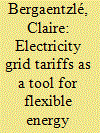

|
|
|
|
|
| Summary/Abstract |
Electricity grid tariffs are a lever for reinforcing the coupling of district heating systems to the electricity system and for activating flexibility from power-to-heat (P2H) technologies and storage capacities. This study assesses three tariffs that permit a flexible use of electric boilers in a representative district heating system in Denmark. A mixed integer programming model is developed to evaluate the impact of each tariff on district heating flexibility quantitatively. The tariffs are then discussed in the light of the regulatory requirements that network tariffs must comply with.
|
|
|
|
|
|
|
|
|
|
|
|
|
|
|
|
| 13 |
ID:
176100


|
|
|
|
|
| Summary/Abstract |
Chile was the first country that privatized all generation, transmission, and distribution services, and introduced competition in the generation segment. Nearly four decades after its creation, many features of the original electricity market design remain unchanged. In this paper, we provide a brief history of the Chilean electricity market and explain its main limitations going forward. Some of these include the use of a cost-based mechanism for spot transactions based on a merit-order curve, low temporal granularity of spot prices, missing forward markets to settle deviations from day-ahead commitments, inefficient pricing of greenhouse gas emissions due to administrative rules, and a capacity mechanism that does not reflect a clear resource adequacy target. Many of these limitations are also present in other electricity markets in Latin America that, when privatized, mirrored many features of the electricity market design in Chile. Failing to address these limitations will provide distorted incentives for the efficient entry and operation of resources that could impart flexibility to the system, increasing the cost of decarbonizing the power sector.
|
|
|
|
|
|
|
|
|
|
|
|
|
|
|
|
| 14 |
ID:
192758


|
|
|
|
|
| Summary/Abstract |
Starting from the EU vision for Energy Communities (EC), our purpose is to support them by proposing a Digital Twin (DT) that includes a bi-level optimization model to deliver coordination, economic, social, and environmental benefits to its members that can be quantified as Key Performance Indicators (KPI). The diversity of EC members from the size and interest perspectives leads us to consider a bi-level optimization model. It offers support to individual consumers/prosumers (first level) and coordination for EC (second level). This model is embedded into a DT that replicates the EC and the operation of individual entities such as consumers/prosumers and public assets. The DT is created as an automatic assistant with two components: iEMS – as a member's assistant and eEMS – as an EC assistant. These components optimize the schedule, generate bids for the Local Electricity Market (LEM) and control the flexible appliances of the participants to deal with deficits and surpluses. The DT receives input from EC members, LEM, metering system and improves the operation of the EC in a two-way continuous exchange data flow. Furthermore, it is a reliable framework to test and improve models, regulations and policies in emergent EC as DT provides alternatives regarding its functionalities: optimization, market operation, setting the clearing price, settlement, value sharing for distributing benefits, etc. It can be extended to support grid operators to design tariffs, testing regulation and offer additional energy services. The proposed DT model is tested within an EC case study, both on a seasonal and an annual basis. The average trading index on LEM is 0.6 during the summer and 0.3 during the winter months, while the Degree of Local Sufficiency (DLS) for the EC is 0.45 in summer and 0.28 in winter. Moreover, the proposed LFM model reduces the exchanges with the main grid by an average of 45 kW in summer, that represents almost 15% of the average exchange at peak hours.
|
|
|
|
|
|
|
|
|
|
|
|
|
|
|
|
| 15 |
ID:
166347
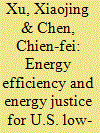

|
|
|
|
|
| Summary/Abstract |
Energy poverty intertwines with the issues of energy inequality and energy justice, presenting a particular challenge for low-income households (LIHs). This study explores energy justice in the U.S. through the lens of several interconnected questions: Do energy assistance programs have adequate participation rates? How accessible are energy efficiency (EE) appliances? Are there different energy practices across income groups? How does time schedule of energy practices differ across income groups, and how is it connected to energy demand flexibility? Based on two representative data sets, this study finds that affordability and accessibility remain serious problems for LIHs. LIHs have lower participation rates in many EE programs and own fewer EE appliances and smart grid technologies. Additionally, thermostat control strategies are different across income levels. LIHs tend to set one fixed temperature, even when they own a programmable thermostat, which is less energy efficient. LIHs engage in more energy practices throughout the daytime than their counterparts and show the least pronounced morning and evening peaks, indicating a relatively inflexible schedule and barriers to accepting demand response programs. This study concludes with policy implications for making energy more affordable, accessible, flexible, and better for the environment, while being fair to those often underserved.
|
|
|
|
|
|
|
|
|
|
|
|
|
|
|
|
| 16 |
ID:
125103


|
|
|
|
|
| Publication |
2013.
|
| Summary/Abstract |
Since the transformation was set in motion to change Western armed forces from large-scale mechanized defensive organizations into smaller agile expeditionary crisis response forces, the call for organizational flexibility has rocketed. Yet, actual research into the key organizational drivers of flexibility has hardly been done. To bridge this gap, the present study has analyzed to what extent modular organizing and organizational sensing have contributed to flexible military crisis response performance. The study uses the Netherlands' armed forces as a representative example of a contemporary Western crisis response organization and empirically draws upon its recent operational experiences. It has uncovered that within most mission contexts, modular organizing acts as a facilitator for the organizational sensing process. Yet, within highly turbulent crisis response missions, organizational sensing becomes the predominant driver, stimulating ad hoc solutions that challenge existing structures, available technology, and standard procedures.
|
|
|
|
|
|
|
|
|
|
|
|
|
|
|
|
| 17 |
ID:
137416


|
|
|
|
|
| Summary/Abstract |
The financing of Common Security and Defence Policy (CSDP) operations questions the capacity of the European Union (EU) to contribute to crisis management. Instead of a single mechanism that would be used for all kinds of missions, different mechanisms are applied, depending on the objective and nature of the operation. The aim of this article is to explain change and inertia in the way these operations are funded. The first section is dedicated to the presentation of the legal framework and its characterization as a fragmented and flexible structure. It allows for identifying the changes that have affected the financing of EU operational activities abroad. The main problems and challenges in financing CSDP operations are dealt with in the second section. The third section explains: (1) why changes have occurred in some areas and (2) why inertia has prevailed in other areas in spite of the problems previously identified. Three main explanations are tested. Rules and practices in financing CSDP operations (1) result from operational needs, (2) are influenced by proactive supranational institutions and (3) are triggered by the Member States. These three explanations are not mutually exclusive. They all contribute to the understanding of CSDP operations, but the relative importance of each factor depends on the operations at hand. Generally, the second factor is at play in the case of civilian operations, while the third one prevails with regard to military operations. The first factor brings a complementary explanation to both kinds of operations.
|
|
|
|
|
|
|
|
|
|
|
|
|
|
|
|
| 18 |
ID:
092869


|
|
|
|
|
| Publication |
2009.
|
| Summary/Abstract |
This article challenges popular wisdom that economic globalization uniformly increases working time in industrialized countries. International investment and trade, they argue, have uneven effects for workplace bargaining over standard hours and over work-time flexibility, such as use of temporary or fixed work contracts. The authors explain how such globalization will tend to more substantially decrease standard hours than it does work-time flexibility. And they explain how works councils and union-led collective bargaining alter the way globalization affects both aspects of working time.The analysis of German enterprise data supports these expectations. Measures of globalization diminish standard working hours but yield more temporary work, fixed-contract work, and flexible working arrangements. Works councils and collective bargaining, however, mediate these effects in contrasting ways. Among enterprises without works councils or collective agreements globalization triggers more standard hours, but among firms with such representation globalization triggers fewer hours. With respect to flexibility, however, globalization increases use of temporary or fixed-term contracts more strongly where works councils or collective bargaining are present than when they are not. In short, economic openness has uneven consequences for working time, and firm-level labor representation channels those consequences in ways that highlight political agency in how people respond to globalization.
|
|
|
|
|
|
|
|
|
|
|
|
|
|
|
|
| 19 |
ID:
079475


|
|
|
|
|
| Publication |
2007.
|
| Summary/Abstract |
Since 1995, Dominica has endured a massive economic downturn following a series of World Trade Organization decisions that have devastated the banana industry, its major export earner. Yet the trade decisions have not been the subject of much anxiety or debate. At the same time, their second largest contributors to foreign exchange earnings (hucksters) are seldom the subject of public discussion. I suggest in this article that these omissions have to do with the manner in which flexibility is culturally conceptualized. Rather than a recent adaptation to the physiopsychological disciplining of a post-Fordian or "globalized" economy, I argue that in Dominica, flexibility is historically constituted through a much longer engagement with capitalism in the formation of the Caribbean as a cultural area over the last five centuries. The entrepreneurial savvy found among hucksters is autochthonous to Dominica's trade culture.
|
|
|
|
|
|
|
|
|
|
|
|
|
|
|
|
| 20 |
ID:
162292
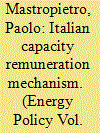

|
|
|
|
|
| Summary/Abstract |
Italy is currently implementing a Capacity Remuneration Mechanism (CRM) in a power sector that is paradoxically characterised, at least for the time being, by a significant overcapacity. This article aims at building a critical review of the Italian CRM design. It first presents the Italian context, explaining how the discussion started more than a decade ago and how it evolved since then. Then, it provides an in-depth description and critical analysis of the mechanism under proposal, based on its main design elements, keeping always as a reference the guidelines issued by the European Commission on CRMs. Many valuable lessons can be extracted from the Italian experience to shed light on other similar processes currently under development.
|
|
|
|
|
|
|
|
|
|
|
|
|
|
|
|
|
|
|
|
|